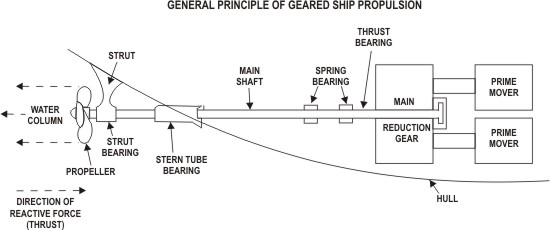|
|
||
|
|
||
|
|
||
|
||
|
|
||
|
The primary function of any marine engineer- eng plant is to convert the chemical energy of fuel into useful work and to use that work in the propulsion of the ship. A propulsion unit consists of the machinery, equipment and controls that are mechanically, electrically, or hydraulically connected to a propulsion shaft. After reading this chapter, you will have a basic understanding of how a ship’s propulsion unit works. You will learn about the three main types of propulsion units used in the Navy. You will also learn how power is transmitted from the propulsion unit to the ship’s propeller through the use of gears, shafts, and clutches. |
From the desktop of
Manuel Paez |
|
|
PRINCIPLES
OF
SHIP
PROPULSION
A
ship moves through the water through propelling
devices,
such
as
paddle
wheels
or
propellers.
These devices
impart
velocity
to
a
column
of
water and
moves
it
in
the
opposite
direction
in
which
it
is
desired
to
move the
ship.
A
force,
called
reactive
force
because
it
reacts
to
the
force
of
the
column
of
water,
is
developed
against
the
velocity-imparting
device.
This
force,
also
called
thrust,
is transmitted
to
the
ship
and
causes
the
ship
to
move
through
the water.
The screw-type propeller is the propulsion device used in almost all naval ships. The thrust developed on the propeller is transmitted to the ship’s structure by the main shaft through the thrust bearing (fig.). The main shaft extends from the main reduction gear shaft of the reduction gear to the propeller. It is supported and held in alignment by the spring bearings, the stern tube bearings, and the strut bearing. The thrust, acting on the propulsion shaft as a result of the pushing effect of the propeller, is transmitted to the ship’s structure by the main thrust bearing. In most ships, the main thrust bearing is located at the forward end of the main shaft within the main reduction gear casing. In some very large ships, however, the main shaft thrust bearing is located farther aft in a machinery space or a shaft alley.
The main reduction gear connects the prime mover (engine) to the shaft. The function of the main reduction gear is to reduce the high rotational speeds of the engine and allow the propeller to operate at lower rotation speeds. In this way, both the engine and the propeller shaft rotate at their most efficient speeds.
|
||
|
If you have
any questions or any suggestions to any subject in these technical issues or
If you want to be removed from this mailing list, please send an e-mail with
your comments to technicalletter@ricepropulsion.com
|
||

